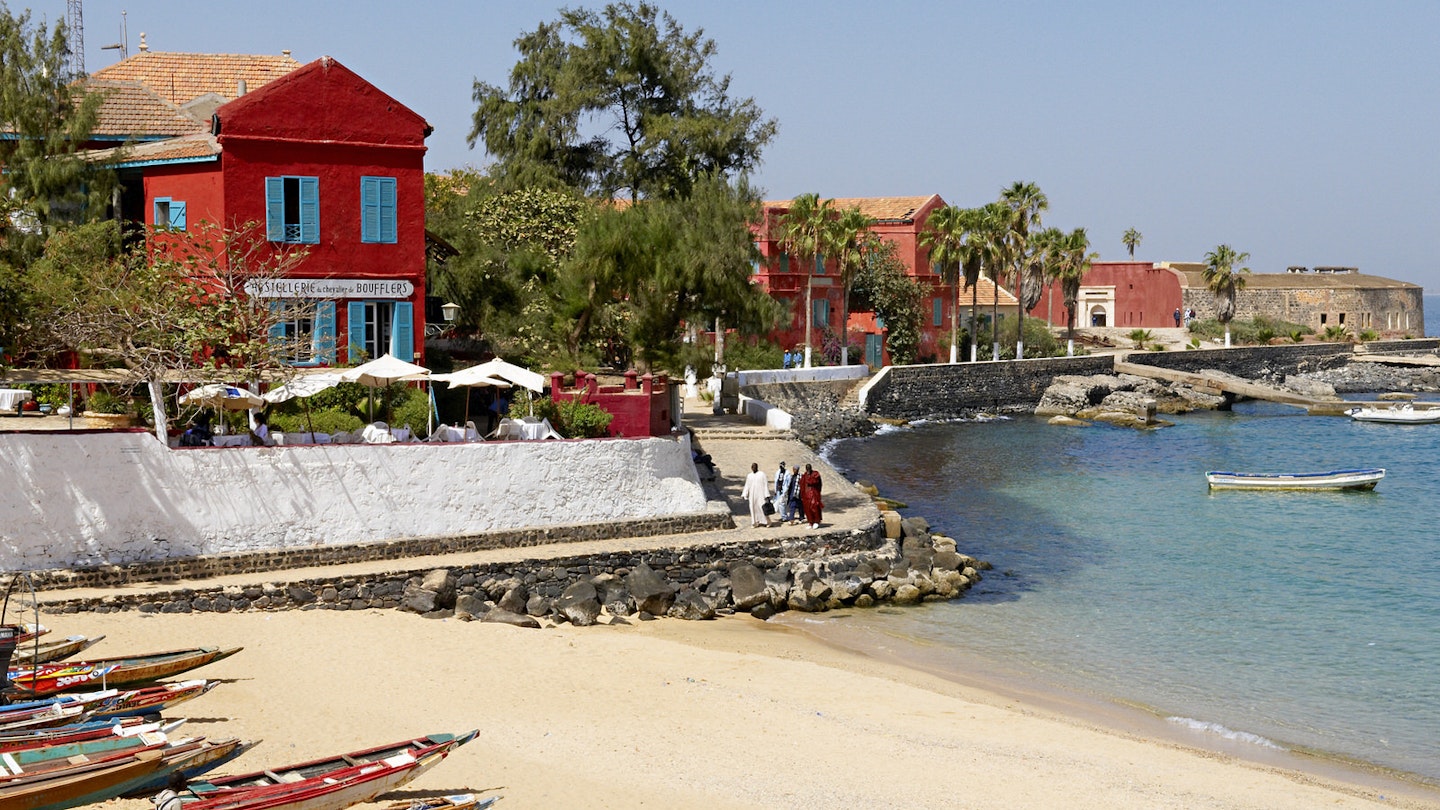One of West Africa’s most dynamic cities, Dakar offers a dizzying mix of sun-kissed beaches, colourful markets, and mbalax-fueled nightclubs where snappily attired revelers emerge into the early morning light as the first call to prayer drifts over the palm-covered landscape. Senegal’s capital is also the gateway to the Île de Gorée, a sleepy tropical island just 3km from the high-rises of downtown.
With its sandy, car-free lanes and bougainvillea-draped colonial buildings, 28-hectare Gorée provides a dramatic contrast to Dakar’s bustling urbanism, making it an ideal day trip. The island’s pastel-hued homes, shimmering beachfront, and fine views are undeniably alluring. Its tranquility, however, belies a heart-breaking past built on the trade in enslaved people – the island stands as a memorial to countless victims who passed through during Africa’s most tragic period.
History of Île de Gorée
Owing to its strategic location, the island was coveted by early European colonists and changed hands dozens of times over the centuries. In 1444, Portuguese navigator Dinis Dias sited the island, christening it ‘Palma’. Within a few years, the Portuguese set up a trading post and built a church and cemetery. The Dutch arrived in the early 1600s, dislodging the Portuguese, though they continued to battle for the island along with the English and the French, the latter of whom ultimately won control by the late 18th century.
Why so many skirmishes over such a tiny island that lacked a reliable source of fresh water? Gorée was at the centre of the European lust for control of the trade in enslaved people. Though there remains no consensus on just how many human captives passed through the island, Gorée remained deeply connected to human enslavement, from 1536 until 1848, when the French abolished the practice.
Following the foundation of Dakar in 1857, Île de Gorée began to decline in importance, and its population plummeted. It remained something of a backwater for the next hundred years, though in 1913 the island saw the opening of a notable teacher’s training college. Many inspired graduates from the school later helped lead the drive toward Senegal’s independence, achieved in 1960. In 1944, the French colonial government declared the island a historic site, forbidding new construction. Then in 1978, the whole island was inscribed on the Unesco World Heritage list.
La Maison des Esclaves
Before the abolition of slavery, there were dozens of warehouses where African captives were held before being shipped off to the New World. The Maison des Esclaves (House of Slaves) serves as a tragic focal point for more than three centuries of suffering. Dating from the 1780s, the building is the oldest on the island and easily its most stirring. The split-level house features a curving, twin staircase leading to the upper floor, where the landowners resided. Displays of iron shackles, muskets, and other artifacts bring the horrors of the past to life. On the lower level are tiny, dimly lit chambers that served as holding cells. A ‘doorway to nowhere’ connected the dungeon-like quarters to the sea, marking a final embarkation point for innocent men, women, and children who were taken from their homeland forever. Although scholars debate whether captives actually passed through this portal, its symbolism is poignant, deeply affecting many visitors to the island, including Nelson Mandela, who was moved to tears on his visit in 1991.
IFAN Historical Museum
On the northern side of the island stands the Fort d’Estrées, an imposing citadel built in the 1850s to defend the harbor. The fortress was never used in combat, though it did serve as a civil prison prior to 1976. Today, its thick walls form the backdrop to a small history museum. The exhibitions cover a lot of ground, from Paleolithic times to the fight for independence from France in the 20th century. The most evocative exhibitions address the island’s role in the trade of human cargo. Outside the museum, stairs lead up to the perimeter wall, which offers hazy views of the modern buildings of Dakar on the horizon.
Exploring Île de Gorée
Aside from the memorials, there’s little evidence on its photogenic lanes of the island’s dark past. The present-day Île de Gorée is home to a vibrant arts community, where you won’t have to go far to discover unique paintings, carvings, and sculptures by resident artists. Painters and artisans set up their shops in the open air, and you’ll find an assortment of jewellery, masks, baskets, textiles, and other treasures on the south side of the island at the marché artisanal. From there, continue up the hill to the ruins of the Fort Saint-Michel, where you’ll find more arts and crafts for sale, as well as magnificent views over the island.
After a walk under the hot Senegalese sun, you can cool off with a dip in the sea. A small beach near the ferry dock is the best place to unwind, where a kiosk hires out chairs and umbrellas. When hunger strikes, you can enjoy seafood, grilled items, or traditional Senegalese fare from one of the simple eateries overlooking the sands. All goes down nicely with a cold Gazelle, a thirst-quenching Senegalese lager.
Visiting Île de Gorée: Make It Happen
The island is an easy jaunt by ferry from Dakar’s main ferry terminal, the Gare Maritime, located just north of the Plateau district. Boats make the 20-minute journey roughly every 90 minutes from 7.30am to 10.30pm, with more frequent departures on Sundays.
While most people visit on day trips from Dakar, there are several appealing places to overnight on the island. The Villa Castel is a charming eco-friendly guesthouse near the centre of Gorée, with doubles starting from around €70. A short walk south of the Maison des Esclaves, the Maison Augustin Ly offers breezy rooms in a classic bougainvillea-draped house from the 18th century, with doubles starting around €55.




